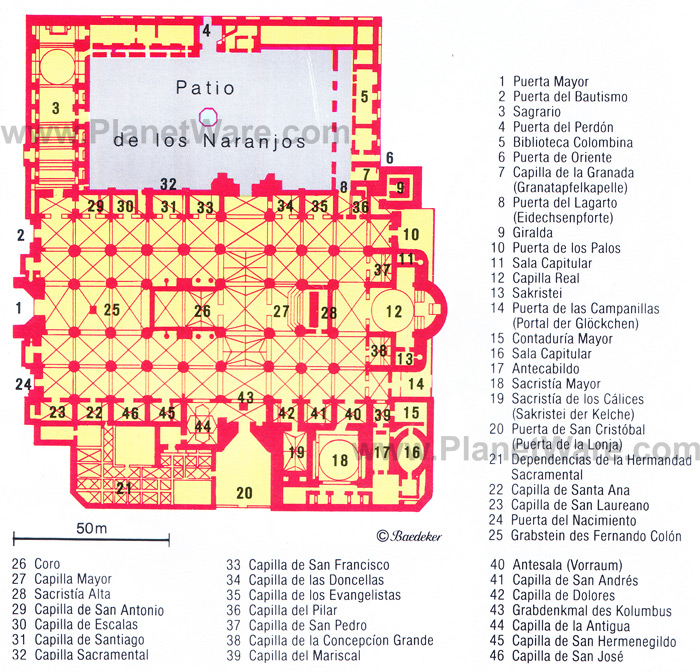The Alcázar of Seville (Spanish “Reales Alcázares de Sevilla” or “Royal Alcazars of Seville”, (Spanish pronunciation: [alˈkaθar])) is a royal palace in Seville, Spain, originally a Moorish fort. The palace is renowned as one of the most beautiful in Spain, being the most outstanding example of mudéjar architecture found on the Iberian Peninsula. The upper levels of the Alcázar are still used by the royal family as the official Seville residence and are administered by the Patrimonio Nacional. It is the oldest royal palace still in use in Europe, and was registered in 1987 by UNESCO as a World Heritage Site, along with the Seville Cathedral and the General Archive of the Indies.
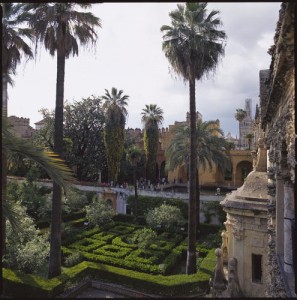
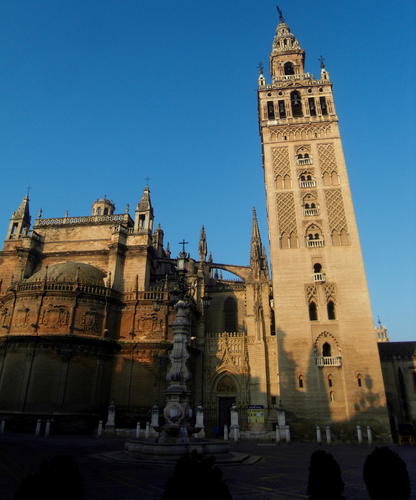
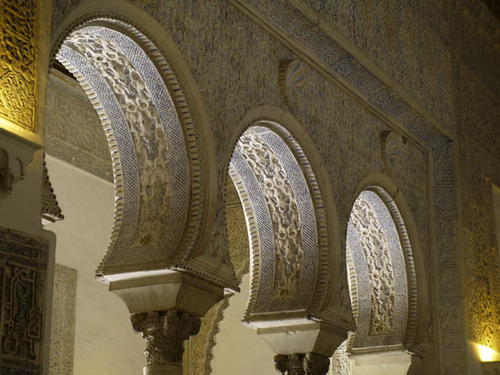
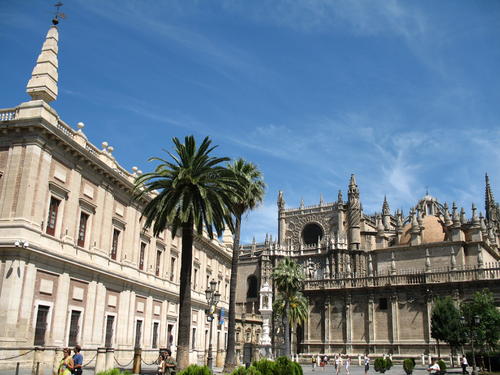
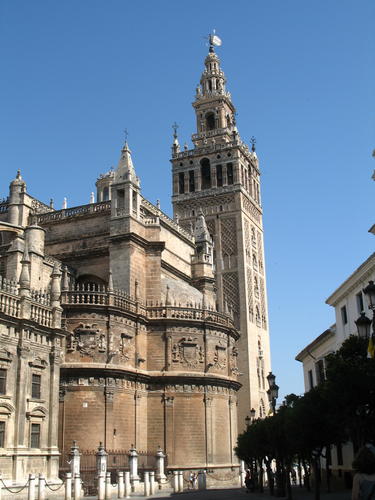
History :
The Real Alcázar is situated near the Cathedral and the General Archive of the Indies in one of Spain’s most emblematic areas.
The Almohades were the first to build a palace, which was called Al-Muwarak, on the site of the modern day Alcázar. It is one of the most representative monumental compounds in the city, the country and the Mediterranean culture. It’s influences held within its walls and gardens began in the Arabic period and continued into the late Middle Ages Mudéjar period right through to the Renaissance, the Baroque era, and the 19th century. Subsequent monarchs have added their own additions to the Alcázar.
The palace was the birthplace of Infanta Maria Antonietta of Spain (1729-1785), daughter of Philip V of Spain and Elisabeth Farnese. The king was in the city to oversee the signing of the Treaty of Seville (1729) which ended the Anglo-Spanish War (1727).
Cathedral Highlights
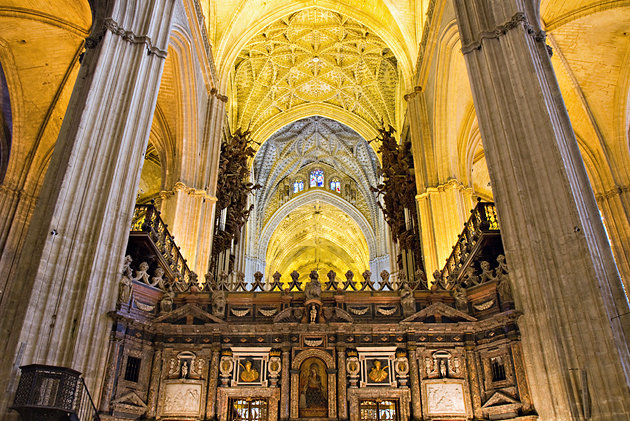
Weathervane
On the east side of the Seville Cathedral, between the Puerta de los Palos and the Puerta de Oriente, which gives access to the Patio de los Naranjos, rises the Giralda, the 93m/305ft high tower which is the landmark and emblem of Seville. The tower was originally built in 1184-96 as the minaret of the Great Mosque; the bell-chamber added in 1568 is topped by a weathervane 4m/13ft high, the Giraldillo, in the form of a female figure representing Faith and carrying the banner of Constantine. From the first gallery, with 24 bells, at a height of 70m/230ft, there are extensive views of the city and surrounding area. Above this gallery is the Matraca, a timber structure housing the rattles which are used during Holy Week instead of bells.
Cathedral – Court of Orange-Trees
The imposing Puerta del Perdón on the north side of the Seville Cathedral, which dates from the Moorish period, leads into the Patio de los Naranjos, originally the forecourt of the mosque. The octagonal Visigothic fountain in the center is a remnant of the Islamic midha, the fountain for religious ablutions.
Capilla de la Granada
In the southeast corner of the Patio de los Naranjos in Seville is the Capilla de la Granada, another relic of the old mosque, with a fine horseshoe arch.
Biblioteca Colombina
On the east side of the Patio de los Naranjos in Seville is the Biblioteca Colombina, founded in the 13th century and enriched by a bequest from Fernando Colón, Columbus’s son, which contains rare works on the discovery of America and valuable manuscripts, including some by Columbus himself.
Cathedral – Doorways
The finest of the Seville Cathedral’s doorways, all of which are richly decorated with statues and reliefs, are the Puerta del Bautismo (Doorway of the Baptism) and the Puerta del Nacimiento (Doorway of the Nativity), to left and right of the Puerta Mayor on the west front, with figural decoration by Lorenzo Mercadante and Pedro Millán. In the south transept is the modern Puerta de San Cristóbal or Puerta de la Lonja; on the east side are the Puerta de las Campanillas (Doorway of the Little Bells) and the Puerta de los Palos.
Cathedral – Interior
The five-aisled interior of the Seville Cathedral (117m/384ft long, 76m/249ft wide, 40m/130ft high) is one of the most impressive among the Gothic churches of Spain, notable for the clarity of its proportions and the beauty of its lines as well as for the abundance of art treasures it contains. Of the 75 stained glass windows (16th-19th century) the oldest are those by Cristóbal Alemán (1504) and Arnao de Flandes (1525-57). At the west end of the nave is the tomb of Columbus’s son Fernando (d. 1539).
Cathedral – Side Chapels
The side chapels of the Seville Cathedral contain numerous tombs and altarpieces. Particularly notable among the altarpieces are two by Murillo, the “Guardian Angel” to the right of the Puerta Mayor and another in the Capilla de San Antonio (the second in the north aisle), with the “Baptism of Christ” and “The Infant Christ appearing to St Antony of Padua”; this chapel also has a picture by Jordaens. Among the finest of the tombs are the Gothic monument of Juan de Cervantes in the Capilla de San Hermenegildo and the Plateresque tomb of Archbishop Mendoza in the Capilla de la Antigua.
Cathedral – Choir
The Seville Cathedral choir has a beautiful reja (grille) of 1519 and Gothic choir-stalls of 1475-79.
Cathedral – Capilla Mayor
In the Capilla Mayor of the Seville Cathedral, which also has a large and richly wrought reja, the dominant feature is the resplendent retablo, a masterpiece of Gothic wood-carving. In the center is a silver image of the Virgen de la Sede surrounded by 45 scenes from the life of Christ and the life of the Virgin.
Monument of Columbus
In the south transept of Seville, just inside the Puerta de San Cristóbal, can be seen the monument of Columbus (by Arturo Mélida), originally erected in Havana Cathedral in 1892 and brought here after the loss of Cuba in the Spanish-American War of 1898.
Capilla Real
Behind the Capilla Mayor, at the east end of the Seville Cathedral, is the Capilla Real, a Renaissance structure 38m/125ft long with a high dome, built between 1551 and 1575 on the site of an earlier royal funerary chapel. Behind the grille (1773) are the tombs of King Alfonso the Wise and his mother Beatrice of Sweden. In the apse are two altars: one in front, with a silver shrine (1729) containing the remains of St Ferdinand, and the other to the rear with a 13th century figure of the Virgen de los Reyes, patroness of the town. Steps beside the front altar lead down to the Panteón, with the tombs of Pedro the Cruel, his wife María de Padilla and several infantes. To the left of the Capilla Real is the Puerta de los Palos.
Cathedral – Sacristía de los Cálices
The Sacristía de los Cálices in the Seville Cathedral, to the right of the Capilla Mayor, contains a famous crucifix by Montañés as well as numerous pictures, including works by Goya, Zurbarán, Morales and Murillo.
Cathedral – Sacristía Mayor
The Sacristía Mayor of the Seville Cathedral, which is entered through an antechamber, is a magnificent 16th century structure with a beautiful domed ceiling. It contains a number of fine pictures, a large candelabrum and a crucifix by Pieter de Kempeneer, and also houses the rich Cathedral Treasury, which includes the key of Seville (1248) and the crown of the Virgen de los Reyes, decked with precious stones.
Chapterhouse
In the southeast corner of the Seville Cathedral the Plateresque Chapterhouse (Sala Capitular; 1530-92) contains Murillo’s ”Immaculate Conception”.
Sagrario
On the north side of the Seville Cathedral, reached through the Puerta del Sagrario (on left), is the Sagrario (1618-62), a handsome Baroque building, now serving as the parish church. It has a retablo with a “Descent from the Cross” by Pedro Roldán.
(((Near the Cathedral)))
Casa Lonja (Archivo General de Indias)
South of the Cathedral in Seville is the Plaza del Triunfo, on the southwest side of which is the Casa Lonja, the former Exchange, a High Renaissance building by Juan de Herrera (1583-98). On the first floor, housed here since 1781, is the General Archive of the Indies, with many thousands of documents relating to the discovery and conquest of America and the Philippines, including autograph documents of Magellan, Pizarro and Cortés, Columbus’s diary and plans of Spanish foundations in the New World.
Address: Avda de la Constitución, E-41071 Seville, Spain
Andalusia Contemporary Art Centre
The Andalusia Contemporary Art Centre in Seville is located in the Cartuja de Santa María de las Cuevas Monastery. The collection includes works by 20th Century artists including Chillida, Ortega Muñoz, Saura, and Gustavo Torner to name a few.
Address: Avenida de Américo Vespucio , 2, E-41092 Seville, Spain
(((North of the Cathedral)))
Plaza San Francisco
The central feature of Seville, a little way north of the Cathedral, is the Plaza San Francisco, once the scene of executions, tournaments and bullfights.
Town Hall
On the west side of the Plaza San Francisco stands the Seville Town Hall, Ayuntamiento, an imposing Renaissance building (1527-64) with a richly decorated east front, one of the most charming examples of Plateresque style. It contains a number of valuable pictures by Zurbarán and other artists.
Address: Plaza Nueva 1, E-41001 Seville, Spain
Plaza Nueva
On the west side of the Town Hall in Seville lies the spacious palm-shaded Plaza Nueva, surrounded by banks and offices.
An equestrian statue stands in the middle of the plaza which is now a pedestrian only zone.
Street of the Snakes
On the north side of the Plaza Nueva is the narrow Calle de las Sierpes, Seville’s main shopping street, now a pedestrian zone lined with shops, cafes and restaurants.
San Salvador
In Calle Jovellanos Gallegos, off Calle de las Sierpes, is Seville’s church of San Salvador, built in the 16th century and radically remodeled in Churrigueresque style at the end of the 18th century. It contains works by Montañés, including an “Ecce Homo”, and a painting by Murillo.
Palacio Lebrija
On Calle de la Cuna in Seville, which runs north from the Plaza San Salvador, is the Palacio Lebrija, a good example of a Sevillian noble mansion, with a large staircase leading up to the entrance and an artesonado ceiling.
Address: Cuna 8, E-41004 Seville, Spain
Old University
The University of Seville was founded in 1502 by the Catholic Majesties and was at that time the School of Santa María of Jesus. Today the university is comprised of 14 faculties, 46,000 students and maintains 2,300 professors.
Address: Calle San Fernando 4, E-41004 Seville, Spain
